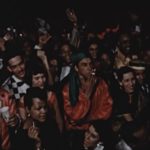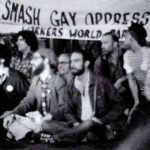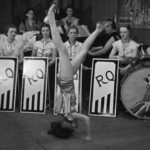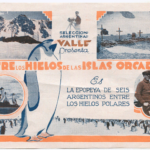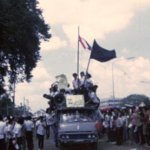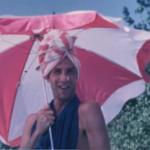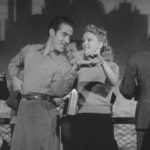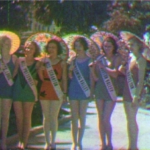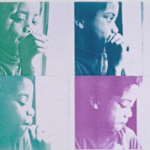Archival Screening Night Encore for Members
ASN Encore for AMIA Members and Conference Attendees
April 28, 2021 | 5:00pm (Pacific)
Screening will begin at 5:00pm (Pacific) and available for viewing for 24 hours
Attendees and AMIA Members will be emailed the link no later than 4pm on April 28th.
Welcome to our first ever Spring Archival Screening Night!
Our virtual event is graciously hosted this year by Wexner Center for the Arts at The Ohio State University!
While we love gathering together with our colleagues to watch the show in a beautiful historic theater, this online platform allows us the gift of wider international representation, and the inclusion of some who may not normally have the option to travel for the conference.
As always, this program represents the magnificent spectrum of formats, works, and collections protected and preserved by the AMIA community. It continues to provide members with an opportunity to showcase recent acquisitions, discoveries, and preservation efforts. We hope you enjoy the show!
Bed Desert (1980)
Institution: Independent
Original Format: Super 8mm
According to Barbara Scharres, writing in the Reader in 1981, Chicago Super 8 filmmaker Norm Bruns worked at a blazing pace with startling boldness. He purchased his Super 8 camera in 1980 and created 11 films in 10 months. Those early films, according to Scharres, are “strikingly in the tradition of Jean Cocteau and of American avant-garde filmmakers like Maya Daren and Curtis Harrington in their concern with personal ritual and the replication of dreamlike states.” Most of his films are in swirling black-and-white, and show an amazing confidence in his skill and vision. As he developed as a filmmaker, his sets and costumes and complicated superimpositions and laboratory techniques expanded his palette and allowed for a deepening of his focus on bodies, city life, dreams and rituals. Unfortunately, Norm passed away in 1990 and his films have not been seen since. Assumed lost by friends, his work was rediscovered and shown two decades later.
Rediscovered in 2019, screened in 2020 (prints only – originals untouched), after a few more screenings they will go to CFA.
Bon Temps Carnival Ball (1956)
Institution: Amistad Research Center
Original Format: 8mm
Home movie footage filmed in 1956 by amateur photographer Robert Green at a Carnival ball in New Orleans, Louisiana. Typically closed affairs, the footage provides a rare look at the annual Mardi Gras celebration of the Bon Temps organization, an African American Carnival club. You’ll see costumes reflecting the theme of “Satan’s Inferno,” some wonderful shots of the costumed audience, and a silent performance from the Louis Jordan band. 35mm interpositive film was digitally scanned at 2K on an Arriscan, then digitally restored, colour graded and output to DCP.
Preserved by Colorlab with a grant from the National Film Preservation Foundation.
May 21st and May 22nd, 1979, New York, NY
Institution: Al Larvick Conservation Fund
Original Format: Super-8mm, black and white, hand processed, silent
This footage is part of a collection of 8mm, Super8, 16mm and videotape formats shot by filmmaker and activist, Jim Hubbard from 1979-2009. On May 21st and May 22nd, 1979 Jim participated in and recorded protests in New York that followed the extremely lenient sentence handed down to Dan White for the assassination of Supervisor Harvey Milk and Mayor George Moscone of San Francisco. The reaction in San Francisco, known as the White Night Riots, was much more militant and historically significant, but demonstrations were held in other cities as well, including New York City. Some of the activities captured in this reel depict unique and inventive forms of resistance that the LGBTQ community brought to the fight for justice. Jim’s Super-8 footage was digitally captured to 2K resolution at Pro8mm. www.jimhubbardfilms.com, www.allarvickfund.org
The Jim Hubbard Lesbian/Gay Community Film Footage collection was conserved and digitized through support from the Al Larvick Conservation Fund.
Creative Leisure (1951)
Institution: American Dance Festival
Original Format: 16mm
Produced by Herbert Kerkow for the U.S. Army and released in 1951 by the Department of Education, Creative Leisure shows Americans spending their spare time engaged in the arts. This excerpt was shot in 1949 at the American Dance Festival/Connecticut College School of Dance and provides a snapshot of the festival during its summer season. There are brief glimpses of notable choreographers and dancers such as José Limón, Betty Jones, Ruth Currier, Valerie Bettis, Jane Dudley, Sophie Maslow, and William Bales, as well as musician Louis Horst and a number of students.
Transferred from 16mm to Apple ProRes 422 HQ by AV/Geeks in 2013.
[Variety Show at Peoria’s Palace Theater – circa 1934]
Institution: Chicago Film Archives
Original Format: 35mm nitrate film with optical sound
Excerpts from a 35mm film documenting a beguiling variety show at Peoria, Illinois’ Palace Theatre in 1934. Performers include tap dancers, singers, contortionists, and a charismatic youngster parodying Mae West.
Donated by Charles E. Krosse in 2006, the film has been inspected and rehoused. It was scanned to 4K in 2020.
South Orkney Islands, Antarctica, 1927
Institution: Museo del Cine Buenos Aires
Original Format: 35mm
Alberto Sorianello worked for many years as a photographer at Cinematografía Valle, the most important film company during the twenties in Buenos Aires. Among many other documentary and feature films, Valle produced Entre los hielos de las Islas Orcadas (Moneta, 1928), the oldest film shot in Antárctica Argentina, it survives in a 16mm print.
Some years ago, Sorianello’s family donated to Museo del Cine some film elements, most of them nitrate. Unfortunately, they presented an advanced stage of decomposition, but not all of them. Leandro Listorti, film researcher at the Museo, discovered a 35mm negative in excellent condition with beautiful footage from Moneta´s film. They are fragments without order, may be material that was not included in the final cut, but is the only element that allows us to imagine how the original print really looks like.
We made a 4k scan from the 35mm nitrate original negative.
Toehold on a Harbour (1965)
Institution: Archives New Zealand Te Rua Mahara o te Kāwanatanga
Original Format: 35mm
In 1965 the National Film Unit (NFU) produced a film to showcase the city’s unique atmosphere and style to domestic and international audiences alike. The film ‘Toehold on a Harbour’ is an entertaining look at life in the 1960s, giving a colourful impression of Wellington city: hills, winding streets, busy people and strong winds.
In 2015, during the 150th anniversary of Wellington as the capital city, ‘Toehold on a Harbour’ was digitally restored through a collaboration between Archives New Zealand, Ngā Taonga Sound & Vision, Park Road Post Production, and the NZ International Film Festival.
35mm interpositive film was digitally scanned at 2K on an Arriscan, then digitally restored, colour graded and output to DCP.
October 14, 1976
Institution: Film Archive, Thailand (Public Organisation)
Original Format: Super 8mm
From Tavisak Viryasiri’s amateur film collection to record moment of National history of Thailand.
2K scan.
Photo credit: Film Archive, Thailand
Joan the Woman (1916)
Institution: George Eastman Museum
Original Format: 35mm
The George Eastman Museum’s recent restoration of Cecil B. DeMille’s first large scale historical epic, “Joan the Woman”, 1916 starring Metropolitan Opera star Geraldine Farrar and Wallace Reid framed the Joan of Arc story with a First World War tale. The film was notable for the first use of the Handschiegl color process.
Cecil B. DeMille’s personal tinted, toned and Handschiegled nitrate print was scanned at George Eastman Museum’s Film Preservation Services. The digital files were sent to Haghefilm Digitaal for film out to 35mm color negative and color print.
Early Mexican TV and Commercials (1956, 1961, 1964)
Institution: Laboratorio Experimental de Cine, Mexico
Original Format: 16mm
In 2019, Tania Espinal—an archivist and friend of the Laboratorio Experimental de Cine (LEC)—donated to our filmmaking collective a collection of ~500 rolls of 16 mm she rescued from a former distributor of French newsreels in Mexico. Among the collection’s non-newsreel material were 1930s-50s ex-pat home movies, formally-produced TV commercials from the 1960s, and several orphaned strips of kinescope. Dating primarily from 1956 broadcasts of the Mexican version of “This Is Your Life,” the latter material proved extremely rare as station identifications and programming announcements for Mexico’s second oldest television channel, XEW-TV.
Special thanks to the Smithsonian Scan Club.
“Accessibly Live” (1984)
Institution: Linear Cycle Productions
Original Format: 3/4 U-Matic videotape
“Accessibly Live” was a weekly live talk program that aired via Public Access television on Group W Cable in Columbia Heights, Minnesota (Minneapolis) from 1985-86, and in Ferguson, Missouri (St. Louis) through American Cablesystems’ Public Access channel from 1987-1991. This program was created and by Joel Knudsen in 1984 as original host and producer. Rich Borowy took over hosting and producing duties in 1985 and continued through 1991.
Attempting to preserve the entire surviving run of this series (1985-1991).
Mario Prizek’s home movies
Institution: Media Commons Archives, University of Toronto
Original Format: 8mm and Super 8mm
A producer at the Canadian Broadcasting Corporation (CBC) from 1951 to 1985, Mario Prizek navigated the closeted 1960s and 1970s with style. This compilation features home movies shot on various cottage holidays Prizek took in Northern Ontario. The films are quite notable for their bold technical experimentation and dreamy homo-eroticism.
A 2K scan of the original 8mm film was completed in 2020. The rehoused originals reside in cold storage.
Estrellas de nuestro cine y una nueva revista (circa 1944)
Institution: Museo del Cine Pablo C. Ducrós Hicken
Original Format: 16mm
Estrellas de nuestro cine y una nueva revista (Stars of Our Cinema and a New Magazine) is the title of a film commercial which promotes the argentine media news magazine Antena. In the commercial, which was produced around 1944, we see various movie stars such as Florence Marly, Judith Sulián, Malisa Zini and Libertad Lamarque visiting the printing press and reading the magazine.
The commercial is preserved in two 16mm reels and is a part of the Peña Rodríguez Collection in the Pablo Ducrós Hicken Museum of Buenos Aires. Its digitization and study responds to an ongoing effort in identifying short-films belonging to the Peña Rodríguez Collection.
Acquired by collectionist Manuel Peña Rodríguez then preserved by Fondo Nacional de las Artes and Museo del Cine Pablo C. Ducrós Hicken.
He’s A Latin From Staten Island (1941)
Institution: UCLA Film & Television Archive
Original Format: 16mm
This humorous Soundie from 1941 features Ricardo Montalban in his screen debut refining his Latin lover image that shot him to fame at MGM in the late 40s. Definitely a product of the day, with objectification and stereotypes present; however, Montalban’s powerful screen presence triumphs above all.
Worn and damaged Soundie print sonic-cleaned; scanned in 4K on the Archive’s ScanStation; raw DPX scans backed-up to LTO-7; ProRes reference files.
Galveston’s Pageant of Pulchritude featuring Dorothy Lamour (1931)
Institution: Texas Archive of the Moving Image
Original Format: 16mm Kodacolor
Held annually from 1920 to 1931, the Pageant of Pulchritude (previously known as the Bathing Girl Revue) signaled the beginning of the summer tourist season in Galveston. This home movie captures many of the contestants in what was to be the final pageant in 1931. Young ladies from all over the globe pose for pictures in their swimsuits at Open Gates, the home of prominent Galveston businessman George Sealy. The contestants include soon-to-be actresses Dorothy Lamour (at the time Lambour) as Miss New Orleans and Daisy D’Ora as Miss Germany. The film was made by George Sealy II and also features his children, Jean and George. While the film appears black and white to the human eye, the film was actually shot in Kodacolor, an early color film stock for the amateur market produced by Eastman Kodak. This film was restored to its full color state through the support of the National Film Preservation Foundation. It is believed to be the earliest existing color moving image of Texas.
This film was held at the Rosenberg Library in Galveston and came to the attention of the Texas Archive of the Moving Image during their Galveston Film Round-Up. TAMI’s staff recognized that the film was not black and white, but instead Kodacolor. They applied for grant assistance to the NFPF to restore the film to color. The film was restored at Colorlab. It can now be accessed via TexasArchive.org.
Poison on the Walls (dir. Eduardo Darino, 1975)
Institution: New York University
Original Format: 16mm
An educational public service film sponsored by the NYC Health Department on the dangers of lead paint, animated with innovative use of a 6500 Xerox color copier by animator Eduardo Darino.
Worn and damaged Soundie print sonic-cleaned; scanned in 4K on the Archive’s ScanStation; raw DPX scans backed-up to LTO-7; ProRes reference files. 16mm film reel discovered in collection of Visiting Nurse Service of NY. Digitized by NYU MIAP.
Liebert Bethune – Pan Africa project outtakes (1971)
Institution: Smithsonian National Musuem ofAfrican American History & Culture
Original Format: 16mm
After completing his film MALCOLM X: STRUGGLE FOR FREEDOM, director Lebert “Sandy” Bethune began a project focusing on thought leaders in the Pan-Africa movement. The unfinished 16mm color film contains interviews with C.L.R James, Shirley Graham Du Bois, Peter Abrahams and Amy Jacques Garvey. This silent clip is of C.L.R James in Harlem, NYC in 1971. The first shot is of Lebert Bethune interviewing C.L.R. James at a table. Next is C.L.R. James in Harlem at Lewis H. Michaux’s African National Memorial Bookstore, where he and Mr. Michaux briefly speak to each other followed by some close-ups of the bookstore front. The final shot is of Mr. James entering the New York Public Library Schomburg Center for Research in Black Culture – which, as can be seen from the placard on the wall, was at the time known as the Schomburg Collection of Negro Literature and History.
To date, we have inspected the films and made 2K DPX scans; we are actively looking for the audio elements.

Photo Credit: UW Libraries, Special Collections, Jean Walkinshaw films and videos, 1966-2003, PH2018-030
Celebrate the Women—Roberta Byrd (1989)
Institution: University of Washington Libraries, Special Collections
Original Format: BetacamSP
Celebrate the Women, produced for KCTS Channel 9 Seattle by Jean Walkinshaw in 1989, was a series of short programs made in honor of Washington State’s centennial. Roberta Byrd was the moderator of KING-TV’s show Face to Face and the first woman and first African American to become principal at Lincoln High School in Seattle. The piece includes interviews with Byrd, where she talks about poverty, segregated education, and the Vietnam War. The episode also covers Byrd’s participation in a boycott of the public schools.
The program was digitized by Jean Walkinshaw with grant funding at the Seattle Community College media center prior to donation of her collection to the University of Washington Libraries, Special Collections.
The Women’s Happy Time Commune (1972)
Institution: Women’s Film Preservation Fund
Original Format: 16mm reversal
The Women’s Happy Time Commune (1972, 47minutes) by Sheila Paige is an improvised comedy/western made in the heady early days of the Women’s Liberation Movement—an era that launched a passel of new feminist filmmakers. It was a time when educational film workshops flowered, independent movies sprung forth, and new distribution circuits spanned the globe. In 1972, Paige co-founded Women Make Movies with filmmaker Ariel Dougherty.
An outlier within the cannon of Second Wave Feminist Films, The Women’s Happy Time Commune is fiction as opposed to documentary, and comic in tone. For years, Paige only knew of a single surviving 16mm print; it was stored in her closet — scratched, spliced, and missing a section.
The Women’s Happy Time Commune (1972) preservation was supported by the Women’s Film Preservation Fund. Lab/archive: Colorlab, Anthology Film Archives.
Pathe News Invades General Electric Experimental Laboratory (1927)
Institution: Sherman Grinberg Film Library
Original Format: 35mm Cellulose Nitrate
A delightful silent film from 1927 H. C. White holds a baton that’s zapped by a Tesla Coil; he holds up an incandescent bulb that lights up; White and his assistants demonstrate various tricks with the ‘lightning bolts.
All of the splices were repaired and then the footage was scanned on a 35mm Lasergraphics Director scanner.
With special thanks to Wexner Center for the Arts at The Ohio State University, the Archival Screening Night Subcommittee, Dennis Doros and the AMIA Board, Laura Rooney, Kristina Kersels, and Beverly Graham. Thank you to all the submitters, presenters, and attendees for making this show a success year after year!


